Performing Arts Center Around the States
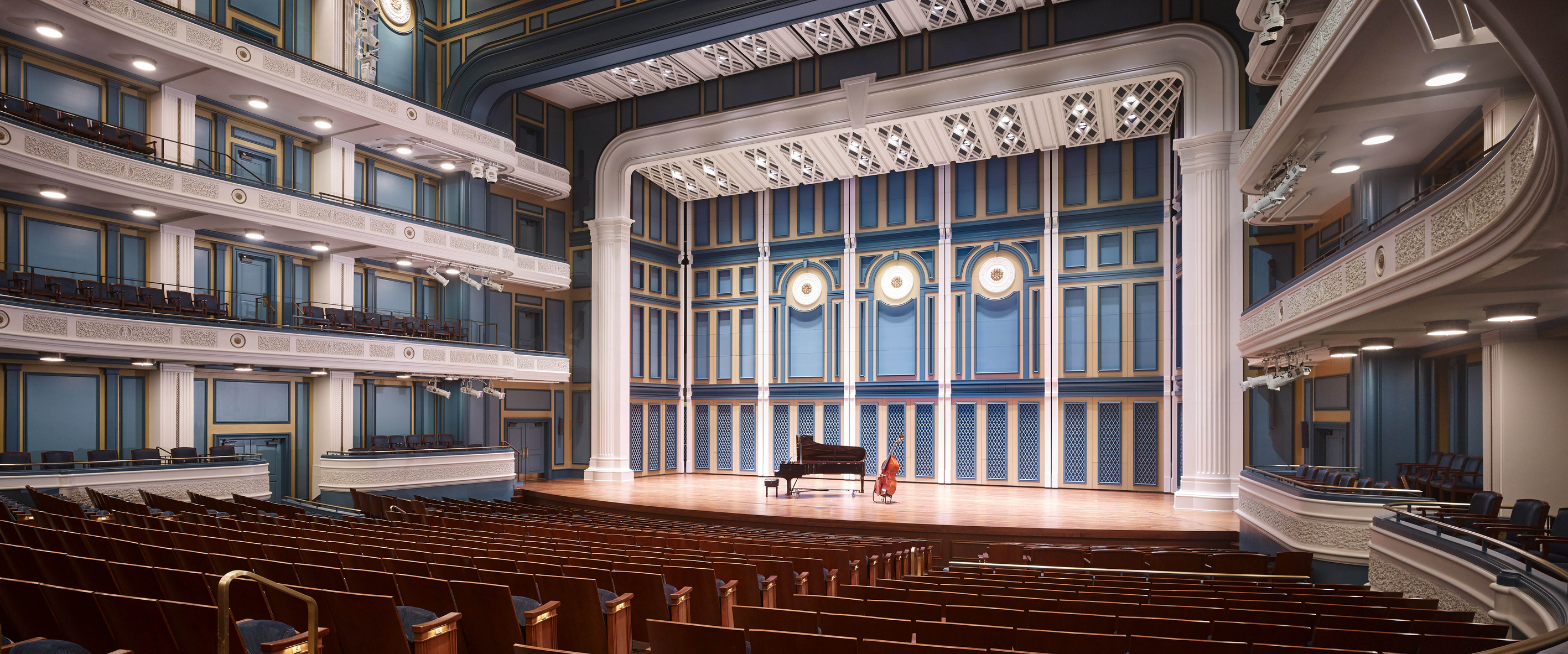
The University of southern mississippi
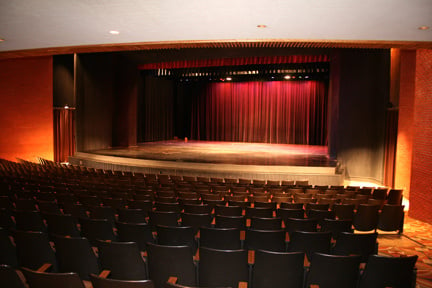
The main stage is named after renowned musician and scholar, Thomas V. Fraschillo
Mannoni Performing Arts Center
- Built in 1972, the Mannoni Performing Arts Center seats up to 740 individuals
- Includes classrooms and equipment, 4 rehearsal halls, 2 dedicated chamber music rehearsal rooms, a computer lab, 8 sound isolation practice rooms with VAE technology, a student common area, 53 practice rooms, and faculty offices and studios
- Damaged by a tornado in 2013, destroying the Jazz station.
- It was then renovated with a new sound system, curtains, lighting, multiple practice rooms, a rehearsal space, and live-streaming technologies. The renovation cost around $5.5 million
- The Mannoni is known to provide good acoustics for both performers and audience members. The main stage is raised with a rectangular frame. The sound system includes digital mixing consoles, amplifiers, and speakers
where does usm stand against its peers?(1)
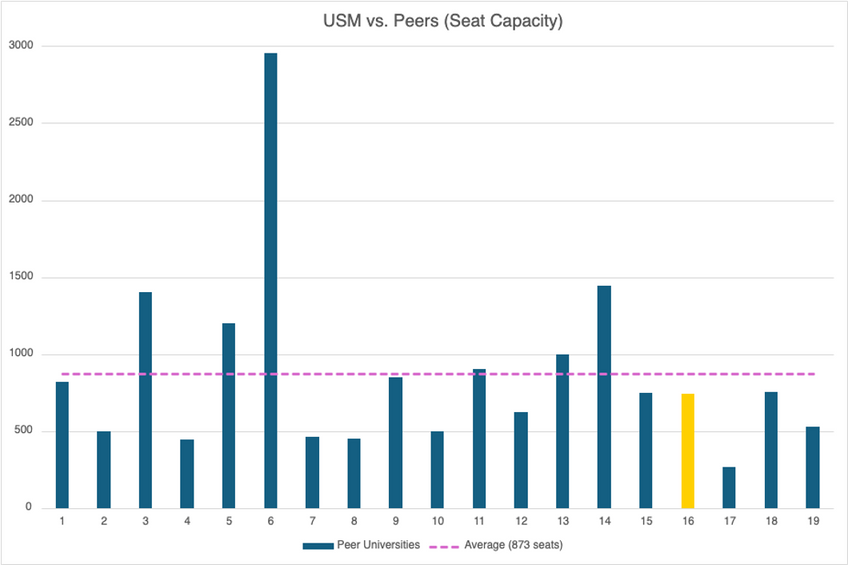
- Bowling Green State University
- Central Michigan University
- Cleveland State University
- New Mexico State University-Las Cruces
- Northern Illinois University
- University of Akron
- University of Albany
- University of Hawaii-Manoa
- University of Louisiana-Lafayette
- University of Massachusetts-Boston
- University of Memphis
- University of Missouri-KC
- University of Montana-Missoula
- University of North Carolina Greensboro
- University of South Alabama
- University of Southern Mississi
- University of Toledo
- University of Wisconsin-Milwaukee
- Wichita State University
USM
The graph above compares the seating capacity of The Mannoni (USM), which is represented by a gold bar, against its peers. The average seat capacity is found to be 873. This puts USM just under the average with a capacity of 740. EJ Thomas Hall of the University of Akron is found to have the highest capacity with 2955.
where does usm stand against its peers?(2)
- Bowling Green State University
- Central Michigan University
- Cleveland State University
- New Mexico State University-Las Cruces
- Northern Illinois University
- University of Akron
- University of Albany
- University of Hawaii-Manoa
- University of Louisiana-Lafayette
- University of Massachusetts-Boston
- University of Memphis
- University of Missouri-KC
- University of Montana-Missoula
- University of North Carolina Greensboro
- University of South Alabama
- University of Southern Mississippi
- University of Toledo
- University of Wisconsin-Milwaukee
- Wichita State University
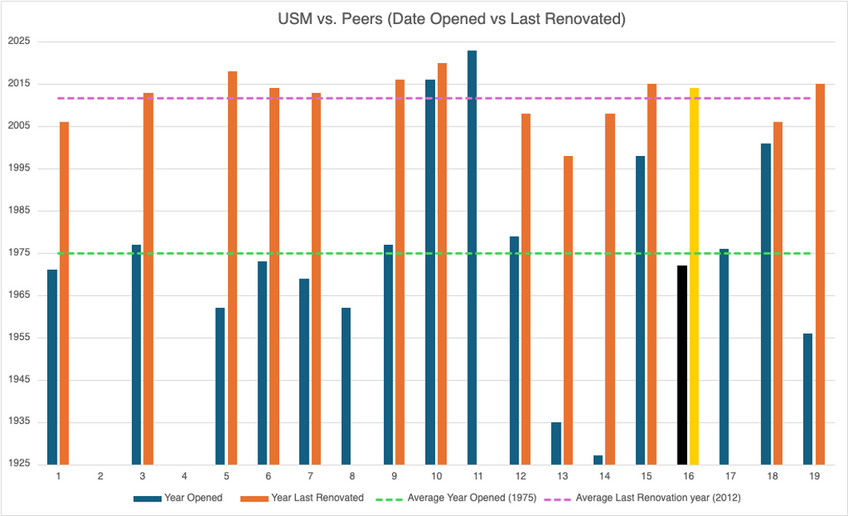
USM
This graph points out when the particular performing arts venue first opened and when it was last renovated. The Mannoni (USM) is represented by the gold and black bars. On average, these performing venues opened in the year 1975. The Mannoni sits just below it in 1972. However, it is seen that, on average, these venues were last renovated in 2012. In this case, the Mannoni sits above the average line with its 2014 renovation.
A Bigger Picture
Out of the 100 universities we reviewed, including USM and its peers, the average seat capacity was found to be 1023.
However, if we exclude USM from this calculation, the average would rise up to 1026.
EJ Thomas Hall of the University of Akron was found to have the highest seat capacity with 2955, followed by Bass Concert Hall (Texas Performing Arts) of the University of Texas Austin with 2900.
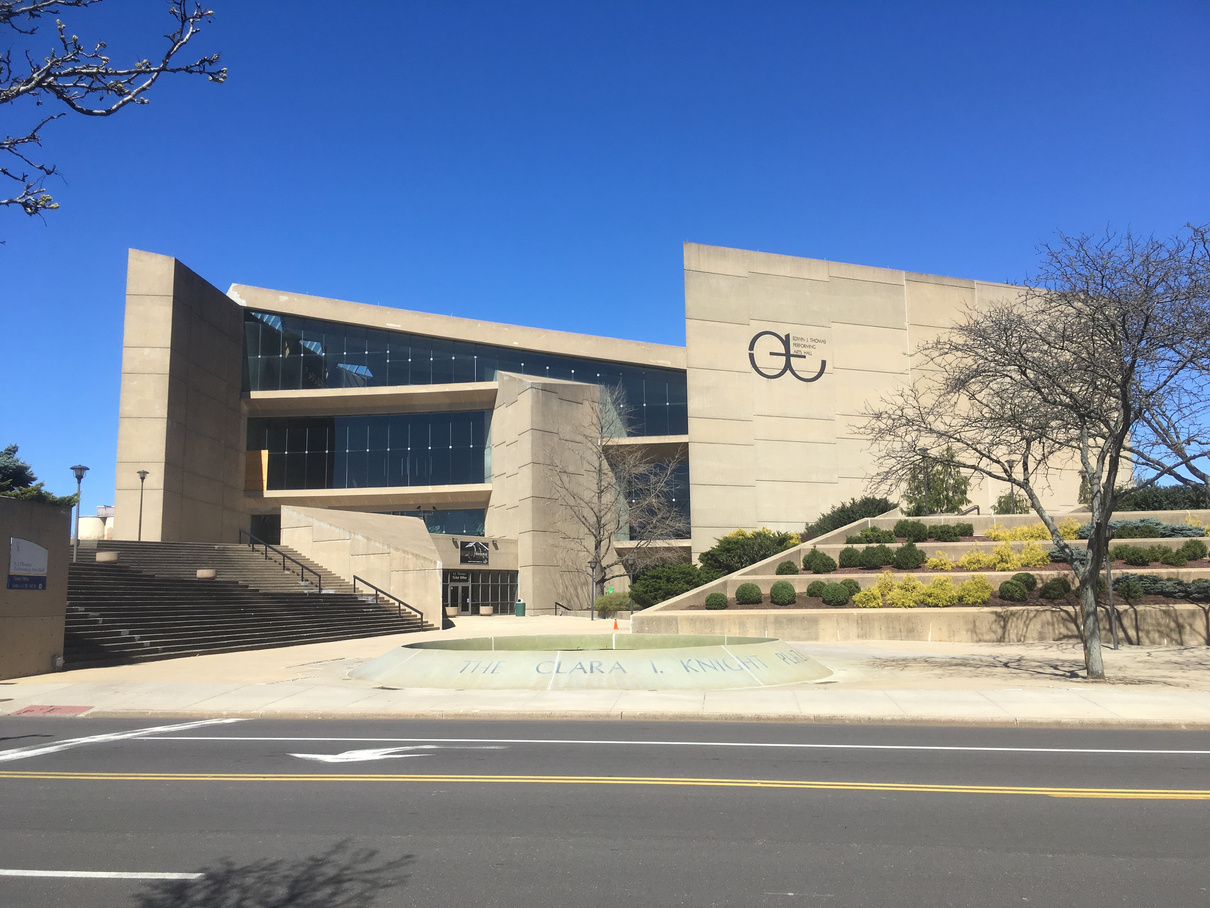
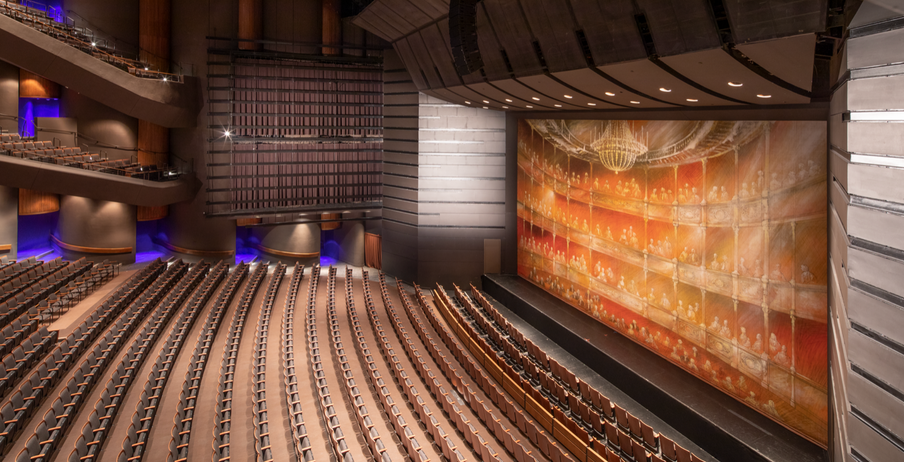
Modernity
The Heindl Center for the Performing Arts (Northwest Mississippi Community College) and the Scheidt Family Performing Arts Center (University of Memphis) are found to be the most recently built centers. Both in 2023.
2023 also saw the renovation of Ed Landreth Hall (Texas Christian University). Additionally, the Bass Concert Hall (the University of Texas Austin) was renovated in 2021 for $3.5 million, making them the two most recently renovated performing arts centers.
Verizon Hall at the Kimmel Center for the Performing Arts (2001) of Curtis Institute of Music is the center built in the 21st century with the highest seat capacity. It seats 2500 individuals.
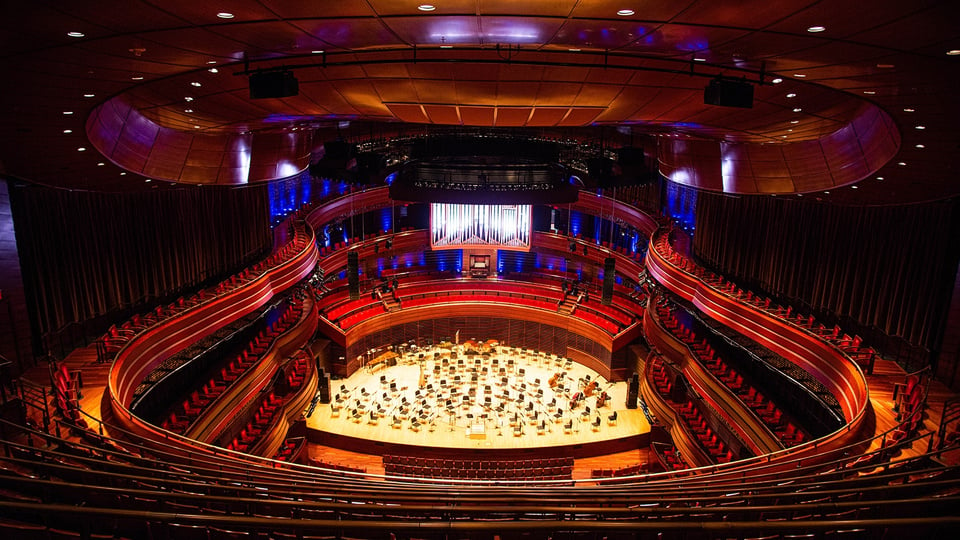
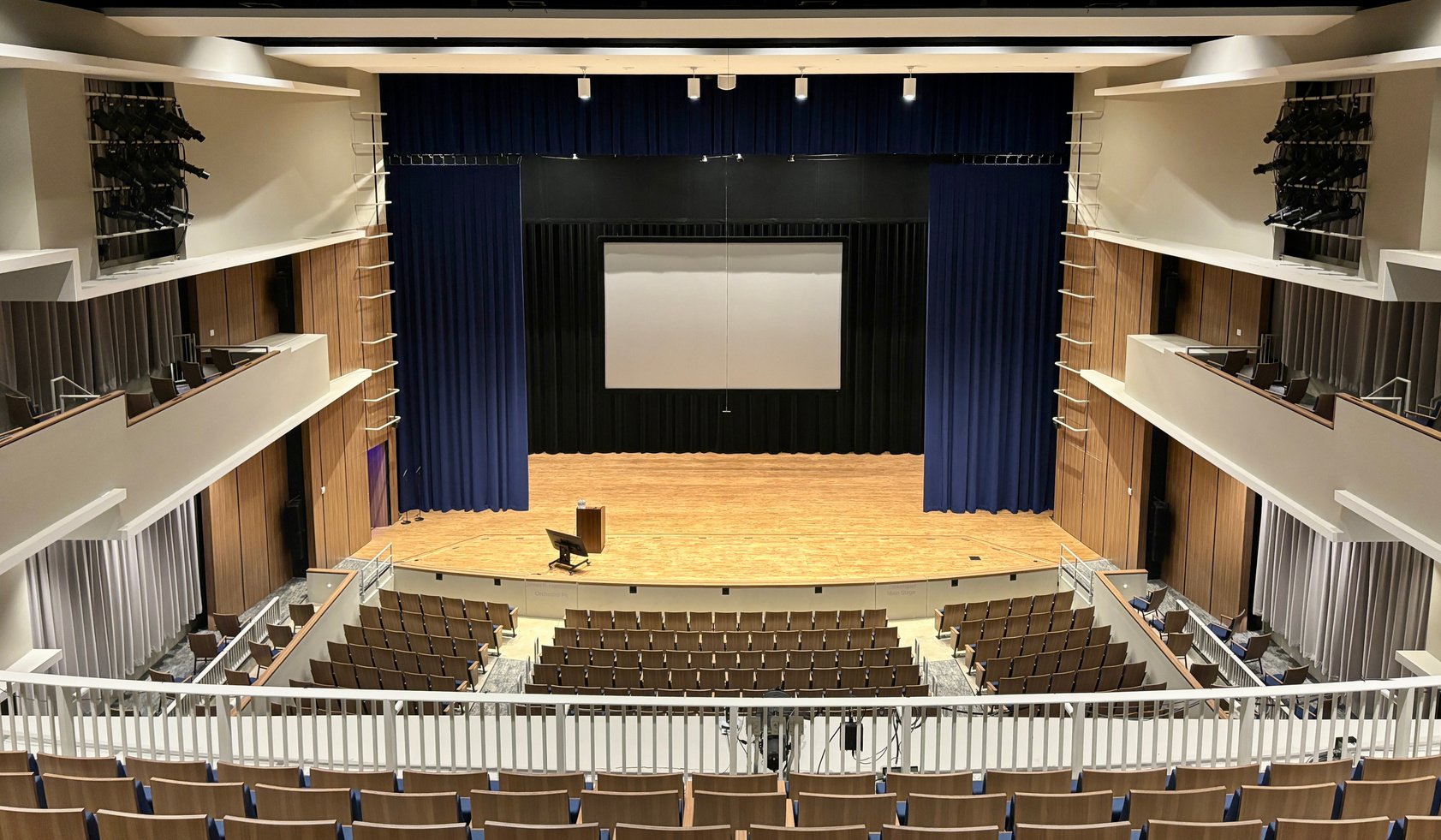
Cost Analysis
The Fisher Center for Performing Arts of Belmont University is one of the most expensive performing arts centers ever built. This 150,000 sq. ft. Neo-Renaissance style building was built in the year 2021 and cost $180,000,000.
Ryan Center for the Musical Art of Northwestern University sits in second place with its $117,000,000 building cost in 2015. This 152,000 sq ft Z-shaped building includes three performance venues Classrooms, teaching labs, academic faculty offices, teaching studios, practice rooms, and a large atrium for public events.
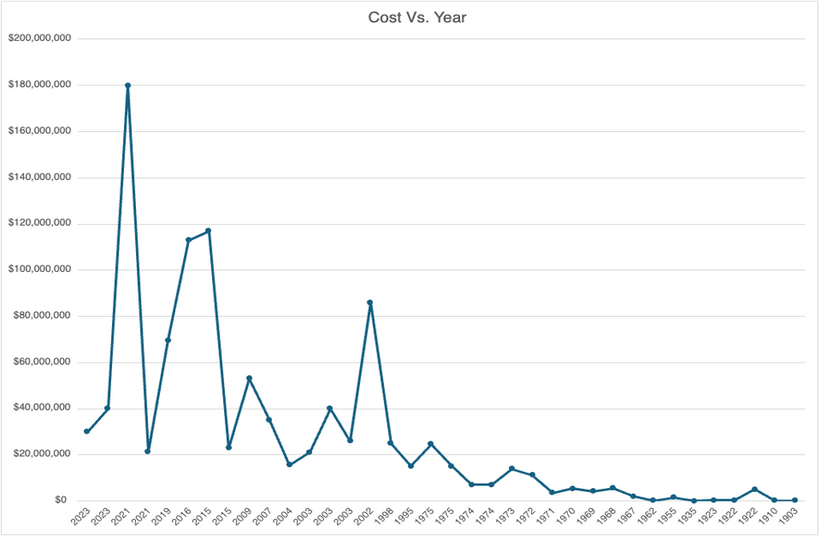
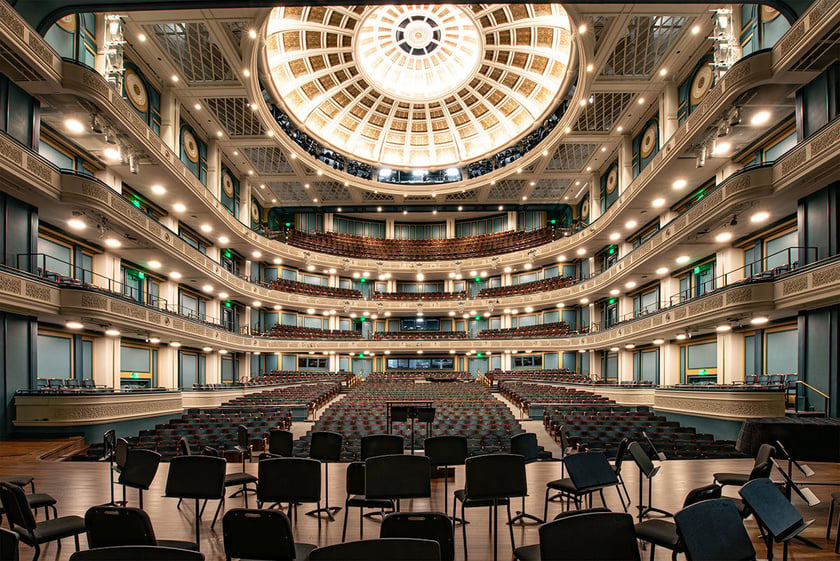
Enrollment Stats (1)
Out of all the universities we reviewed, Berklee College of Music hosts the largest number of music students with 8,448, followed by the University of North Texas with 1600.
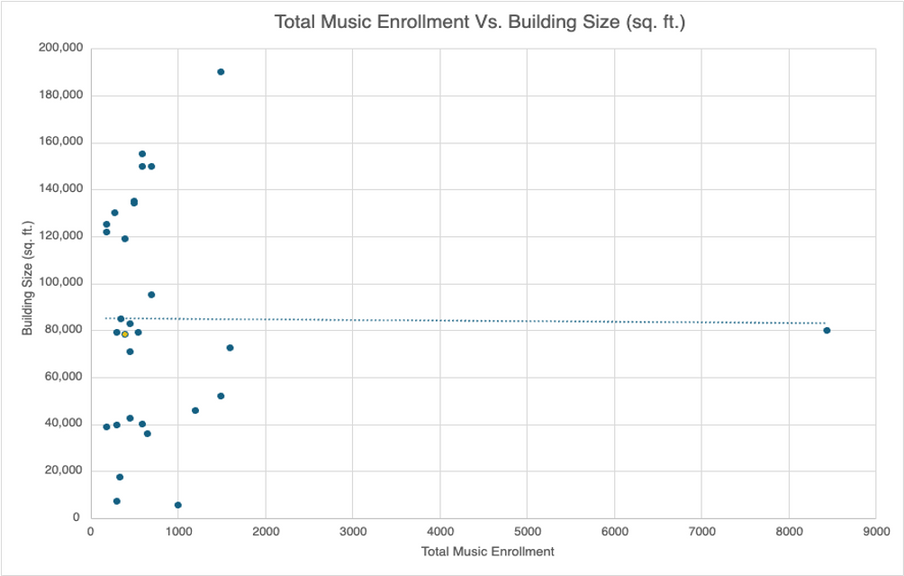
This scatter plot shows the relationship between the total music enrollment and the size of the performing arts building (sq. ft.). The plot at the far right represents Berklee at (8448, 80000) coordinate. The 80,000 sq. ft. represents the Berklee Performance Center (BPC). This plot distorts the entire graph and so do the plots of other large music conservatories. They are clearly an outlier in this case.
The New School and it’s College of Performing Arts see the highest number of music students per square foot of the Performing Arts Center with 0.1818. Again, this stat is followed by Berklee College of Music with 0.1056.
Enrollment Stats (2)
These graphs don’t include Berklee and other similar music conservatories.
The scatter plot shows a weak, positive correlation between these two variables, meaning that larger buildings tend to have slightly higher enrollment. However, this correlation also suggests that building size is not a primary factor in determining music enrollment.
Besides the New School with 0.1818, The University of North Texas sees the second highest number of music students per square foot with 0.0221. The average is 0.01427 and USM has 0.0051 music students per sq. ft.
The bar graph shows the total number of music students per seating capacity of the performing arts center. USM is represented by the gold bar. The average is found to be 0.67, which puts USM just below the average with 0.54 students per seat.
The New School is the one with the highest music student-to-seat ratio of 2.14, followed by New York University with 1.76.
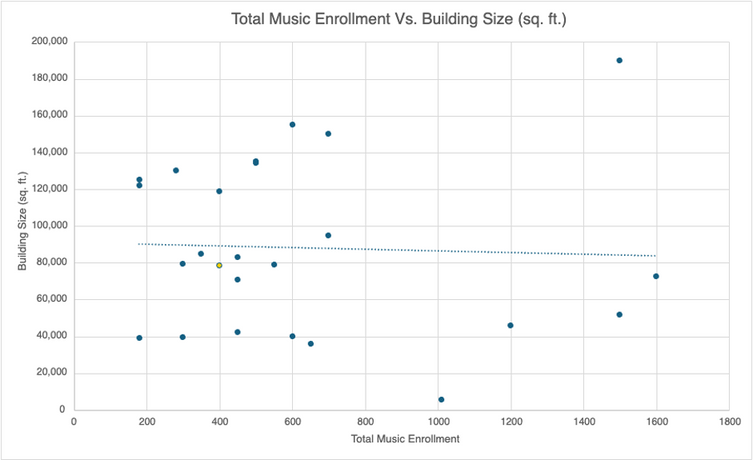
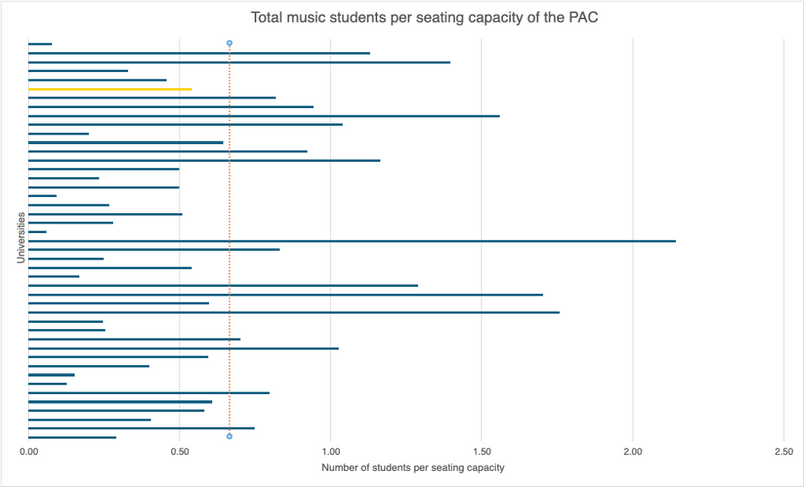
USM with 0.54
Average (0.67)
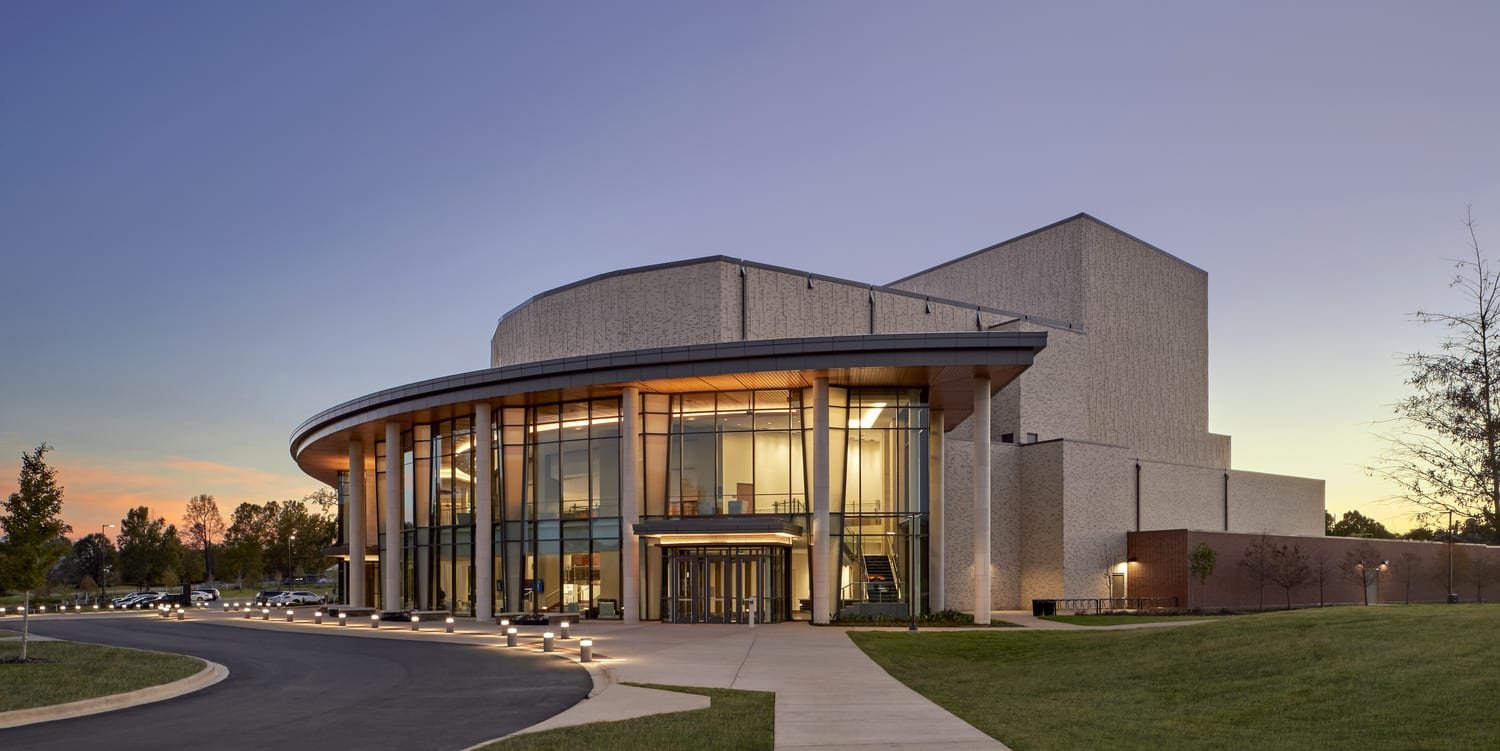
Architecture
The architecture of a Performing Arts Center plays a vital role in enhancing the audio-visual experience.
The Fisher Center of Belmont University (2021)
Seat Capacity - 1727
The design is inspired by the grand concert halls of Europe, with a focus on acoustics and aesthetics
Includes one performance hall, two multipurpose ballrooms, rehearsal space, dressing rooms, and impressive technical facilities
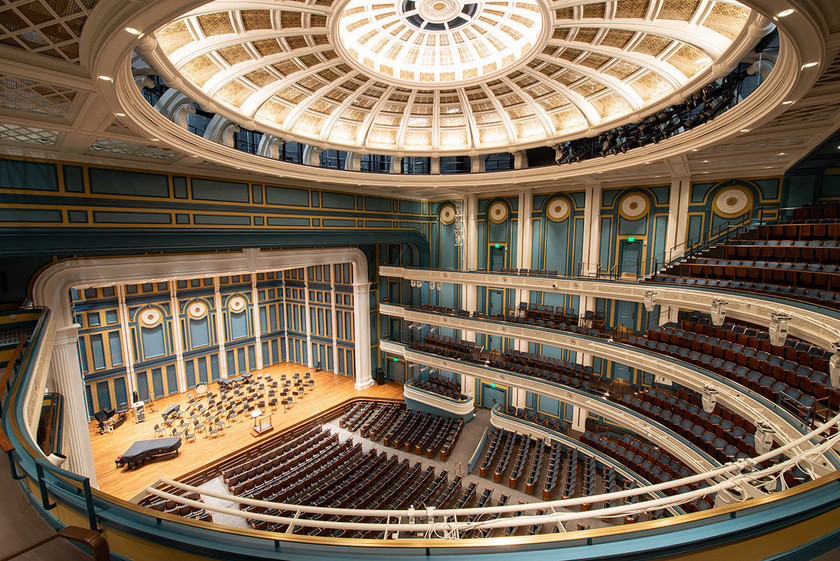
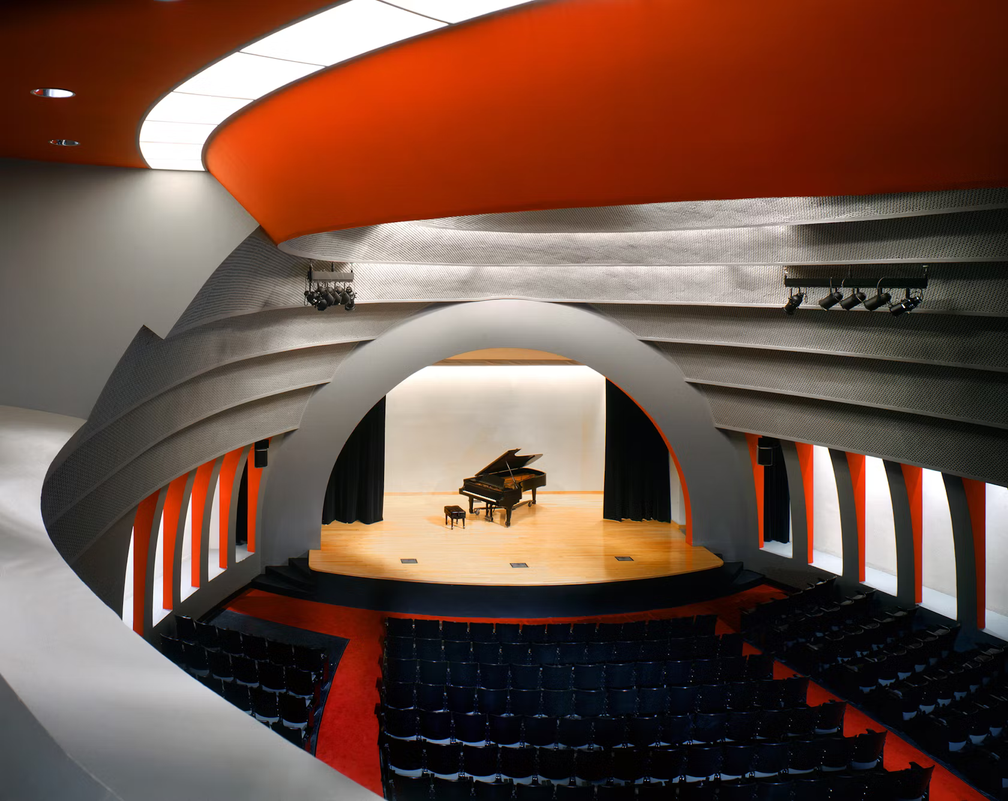
Tishman Auditorium of The New School (1992)
Seat Capacity - 471
When the telescopic seating stored in rooms U201 to U202, on the second floor is added, the auditorium can accommodate 800 people.
Received the 2017 AIA New York Chapter Design Award
Stage size - 34’ downstage width, 29’ upstage width, and 25’6” centerline depth
Conrad Prebys Music Center of UC San Diego (2009)
Seat Capacity - 400 seat concert hall and 150 recital hall
Includes a concert hall, a recital hall, and a variety of rehearsal spaces, classrooms, and offices
Received the 2019 AIA San Diego Chapter Design Award
Previously hosted the annual UC San Diego Summerfest La Jolla music festival
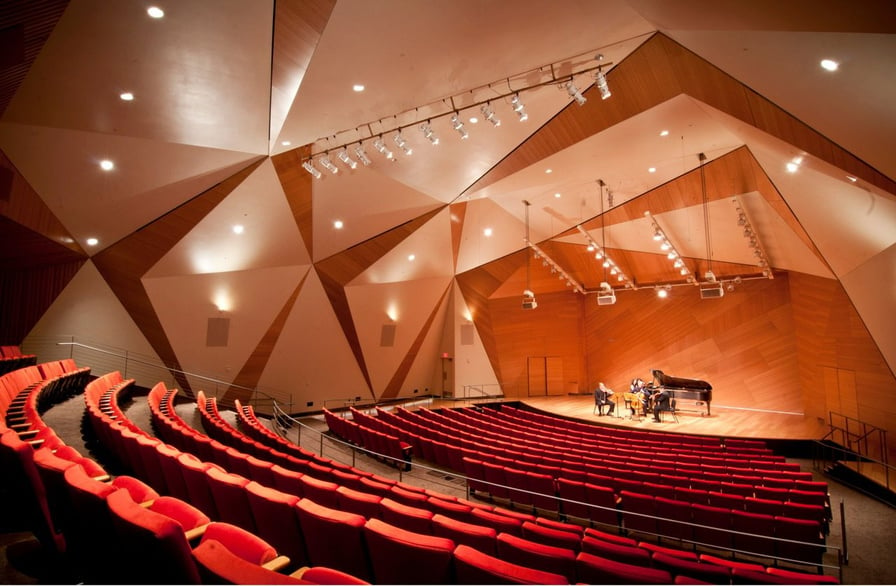
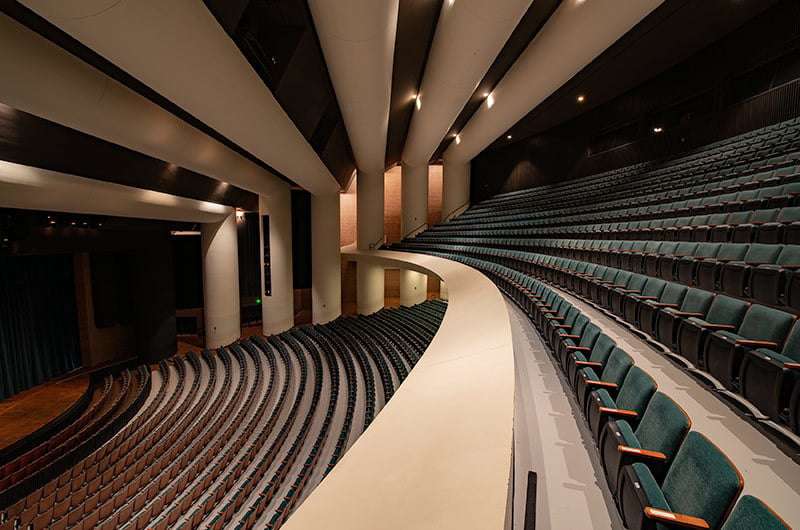
Wharton Center for Performing Arts of Michigan State University (1982)
Seat Capacity - 2420 seat concert hall and 600 recital hall
Received several awards and recognitions, including the 1983 Governor's Award for Excellence in the Arts
Hosted Chicago Symphony Orchestra's opening night performance in 1982
Scheidt Family Performing Arts Center of the University of Memphis (2023)
Seat Capacity - 900
This 82,000 sq. ft. building was designed to incorporate a combination of modern and classical elements
Previously hosted the grand opening gala and the Honey Music Festival
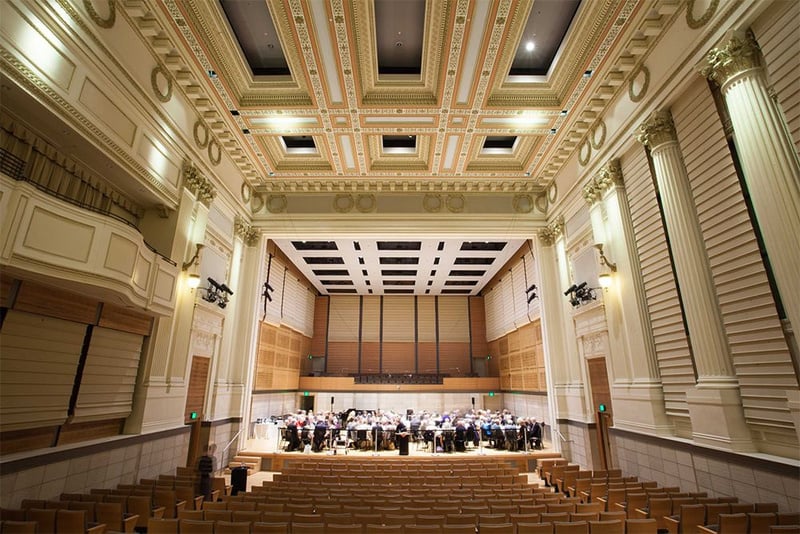
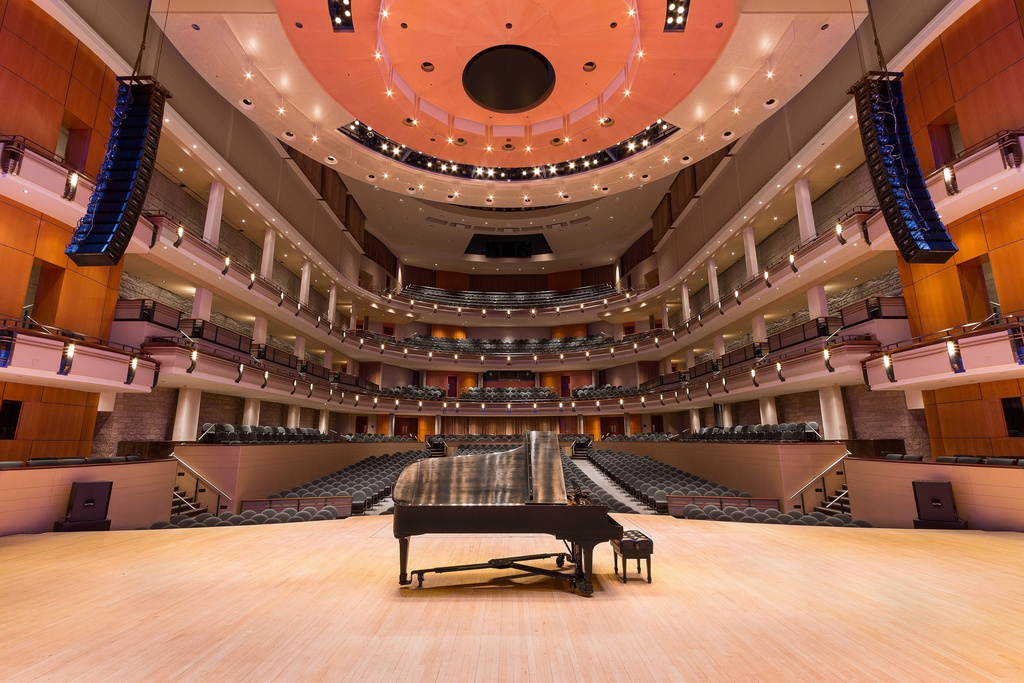
Winspear Performance Hall of the University of North Texas (1999)
Seat Capacity - 1025
Received the 2006 Texas Society of Architects Design Award
Previously hosted the Denton Arts and Jazz Festival
The University of North Texas College of Music, is known to be one of the largest and most comprehensive music schools in the country
Where Can We Improve?
The Mannoni is not large enough for high-demand events. Seat capacity could limit ticket availability for large-scale productions.
Also, for large-scale productions and complex stage designs, the backstage area and the dressing room feel cramped.
The center feels technologically limited when compared to modern venues. For instance, the audio amplification system is not state-of-the-art, and multimedia elements such as digital screens and interactive displays are not present.
Some parts of the building feel dated compared to modern performing arts venues.
So, part of what this project aims is to build a state-of-the-art performance facility with modern recording technologies and more functional spaces like galleries, vendor spaces, and lobbies. These upgrades will not only attract more viewers but will also aid in attracting investors, and other revenue sources.

A Research by
Utkarsha Dahal
Masters in Computer Science
Research Assistant, School of Finance, USM
ADDRESS
Hattiesburg, Mississippi, 39401
School ID
10175891
w10175891@usm.edu
The 100 Universities reviewed for this purpose
- Auburn University
- Ball State University
- Belmont University
- Berklee College of Music
- Boston University
- Bowling Green State University
- California Institute for the Arts (CalArts)
- Carnegie Mellon University
- Central Michigan University
- City University of New York
- Cleveland Institute of Music
- Cleveland State University
- Coastal Alabama Community College
- Columbus State University
- Curtis Institute of Music
- Delta State University
- East Carolina University
- Five Towns College
- Florida State University
- Hinds County Community College
- Indiana University
- Ithaca College
- Jackson State University
- Johns Hopkins University
- Kent State University
- Louisiana State University
- Manhattan School of Music
- Meridian Community College
- Michigan State University
- Middle Tennessee State University
- Mississippi Gulf Coast Community College
- Mississippi State University
- Musicians Institute
- New England Conservatory of Music
- New Mexico State University-Las Cruces
- New York University
- Northern Illinois University
- Northwest Mississippi Community College
- Northwestern University
- Rutgers University
- San Francisco Conservatory of Music
- Shenandoah University
- Southeastern Louisiana University
- Southern Illinois University-Edwardsville
- Stony Brook University
- Temple University
- Texas Christian University
- Texas State University
- Texas Tech University
- Texas Woman’s University
- The Julliard School
- The New School
- Troy University
- Tulane University
- University of Akron
- University of Alabama-Birmingham
- University of Alabama-Tuscaloosa
- University of Albany
- University of Arkansas
- University of California-San Diego
- University of Cincinnati
- University of Colorado-Boulder
- University of Connecticut
- University of Florida
- University of Georgia
- University of Hawaii-Manoa
- University of Kentucky
- University of Louisiana-Lafayette
- University of Louisiana-Monroe
- University of Massachusetts-Boston
- University of Memphis
- University of Miami
- University of Michigan
- University of Mississippi
- University of Missouri-KC
- University of Montana-Missoula
- University of New Orleans
- University of North Carolina Greensboro
- University of North Texas
- University of Oklahoma
- University of Oregon
- University of Rochester
- University of South Alabama
- University of South Carolina
- University of Southern California
- University of Southern Mississippi
- University of Tennessee
- University of Texas-Austin
- University of Texas-El Paso
- University of Toledo
- University of Washington
- University of West Florida
- University of Wisconsin-Madison
- University of Wisconsin-Milwaukee
- Valdosta State University
- Western Kentucky University
- Western Michigan University
- Wichita State University
- William Carey University
- Yale University
